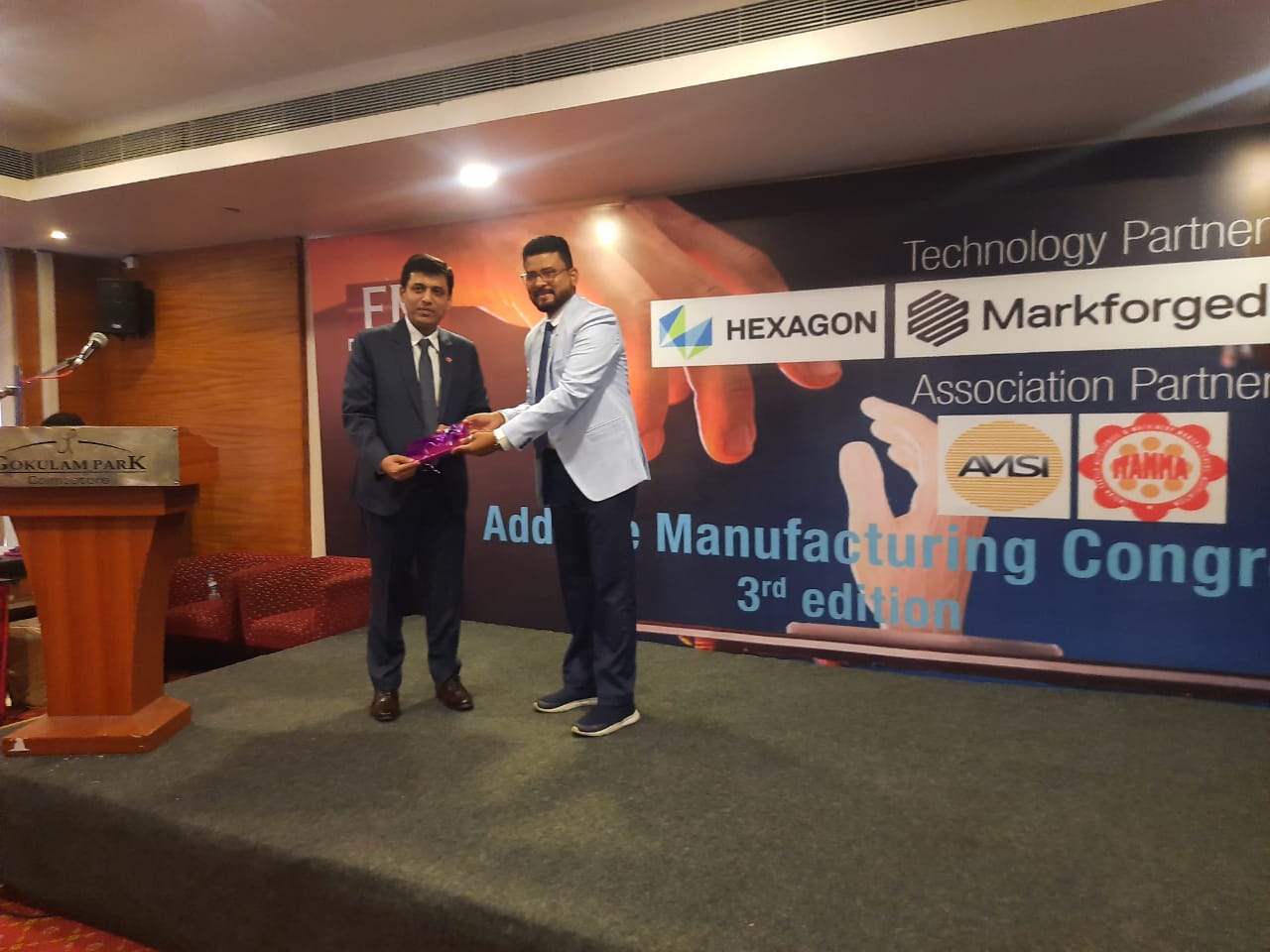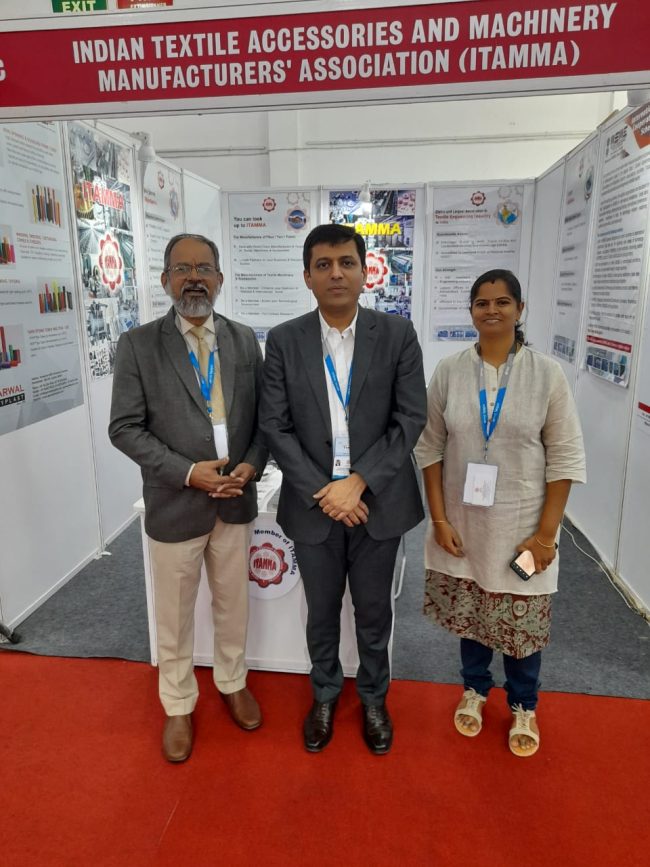
Texfair 2022 registers a record winning enrolment of new members
Many ITAMMA members got an opportunity to know the latest technological developments taken place in the field of “3D-Technology”from the stalwards of the industry
Considering the environment during the Texfair exhibition for ease of doing business, ITAMMA prepared its strategy with a focus on interaction with the entrepreneurs/ enterprises from the textile supply industry to explain them about the proactive involvement of ITAMMA with it’s various activities/schemes for the development of Textile Engineering Industry.
ITAMMA’s participation in the “Additive Manufacturing Congress” organised by EM-Efficient Manufacturing magazine group on June 21, 2022 at Hotel as the Supporting Association.
Many ITAMMA members got an opportunity to know the latest technological developments taken place in the field of “3D-Technology” from the stalwards of the industry.
Purvik Panchal, President of ITAMMA, delivered his key-note address on “Textile Trends After COVID-19” where he mentioned;
The benefits of additive manufacturing on supply chains takes many forms. It reduces material waste, simplifies production processes, and the on-demand production offered by additive manufacturing improves supply chain flexibility because the finished product can be manufactured in proximity to the end-user.
Customers can acquire products, spare parts, and goods as needed, and businesses can produce parts as needed or forecast. Since a single 3D printer can produce a complete part without the need for tooling, it reduces dependence on fixtures and lowers production time.
The application of additive manufacturing, well known as 3D printing, in textile industry is not more totally new. It is giving significant increase of the product variety, production stages reduction, widens the application areas of textiles, customization of design and properties of products according to the type of applications requirement
The advancing technical possibilities in 3D printing and 3D scanning make developments possible that will revolutionize production and trade in the fashion and textile industry. Clothing and shoes will soon be coming out of the 3D printer in an individualized way, new possibilities will open up for functional textiles, and 4D printing will take the 3D process to a new level with fascinating applications.
The 3D simulation makes the creation of the collection faster, more accurate and more cost-effective. If the prototype production is shortened, idle times and waiting times are eliminated and variants are possible at any time. This gives the company more flexibility and enables it to react much faster to new trends.
In the production of technical textiles, the main focus is on functional properties. For textile companies, 3D printing processes open up possibilities that cannot be realized with conventional processes. Elements such as plug-in connections can be applied directly to textile surfaces using 3D printing. In this way, textiles are created that integrate functionalities right from the start.
However, the use of 3D printers in the production of textiles is extremely complex, as plastic filaments are not used as usual.
Possible applications include tailor-made components made of narrow textiles and plastics for technical applications, the application of 3D structural elements for textile sun and noise protection, sportswear and the application of adapted mould reinforcements for protective and functional clothing.
By using 3D printing in production, the textile industry can not only functionally optimize its products right from the start, but production steps such as cutting, sewing or gluing functional components to a textile can even be saved in this way.
For 4D biometric printing, the researchers use a special hydrogel that contains cellulose fibres and transforms into an appropriate form upon contact with liquid. Areas in which the hydrogel could be used range from biomedicine and robotics to textile production and electronics.
The digitalisation of the textile industry and further development of 3D/4D technology is leading to a strong change in the industry. In the near future, tailor-made products will become realistic for consumers, production will be replaced by flexible production facilities at the point of sale and innovative applications for functional and smart textiles will be developed. The environment also benefits from the elimination of transport routes and textile waste generated during production.
With the help of Make in India drive, followed by ATMA Nirbhar Bharat and well supported by Vocal for Local, India is on the path of becoming the hub for hi-tech manufacturing. Whereby global giants have either set up or are in process of setting up manufacturing plants in India, thus many textile machine companies in the country are joining hands with their western counterparts to produce technologically advanced machines.
And accordingly we at ITAMMA, focused all our activities to improve the technological capability of our member companies through various Technology Development Programmes like 5S, Lean, Design Clinics, Energy Audits, Yellow belt trainings etc. under Cluster Development initiatives, in order to help them to have a sustainable growth in today’s smart manufacturing competitive global market. ITAMMA is also helping its members to work on Basic and Applied R & D Projects under the various schemes of government bodies viz., MOT, MHI, MSME, DST, etc.
Today’s seminar subject of “3D printing technology” will be playing a very vital role in the changing trends of Man-Made Textiles, not only in the stream of Fashion designing but also in the Safety Textiles and its machineries. This Technology offers enormous opportunities in production, design and performance.
ITAMMA invited MoU Partners as Guest Speakers for the Seminar on “Trends in Textile Industry after COVID-19” at Jenny Club, Coimbatore on 25th June 22 which was attended by more than 78 delegates.

The Seminar was organised with an objective to connect ITAMMA Members as Industry Stake-Holders, Stalwarts and Scientists of PSG College of Technology as Knowledge Partner and ITAMMA as Industry Association facilitator and explore Technical Project Proposals, (joint Projects in the subject of Low-cost Innovations and Energy Saving aspects )which can be jointly submitted to the Government Bodies like MHI, PCRA, DST, etc for funding under various schemes.
Purvik Panchal, President of ITAMMA, delivered his Welcome Speech where he mentioned that, “Covid 19 / Corona Virus made our life fearful, but there is always a spark of light in the dark environment. India being an opportunist country and Jugad based economy, Indian has flourished in the difficult situation, and we are 2nd highest supplier of PPE kits in the world during this difficult period. In a short span of time, Indian has transferred operation from conventional garment / fabric units to PPE kits units. India has always proved to be in the front when it calls for low cost innovations, whereby an appreciation needs to be recorded for those ITAMMA members who has developed the mask making and automatic sanitizer disposal machines and disinfection chambers during the crucial and challenging Lockdown period.”
Its noteworthy to mention that the demand for man-made fibre (MMF) textiles all over the world is increasing as a substitute for cotton amid changes in global fashion trends. Currently MMF dominates global textile fibre consumption with 72: 28 ratio i.e., MMF 72% and 28% is Natural fibre. Whereby the Global end-use demand for textile fibres is forecast to expand by an average of 2.80% per annum between 2015 and 2025, from 90.10 mn tons to 119.20 mn tons and global end-use demand for man-made fibres is expected to increase by 3.7% in 2025.
At the same time the demand for Artificial Textile Machinery is also increasing with a total trade of $887M. Looking at the Global scenario, Indian Govt. is also promoting man-made fibres and thus it is an alarm as well as opportunity to Indian Textile Machinery Manufacturers for the development of machines especially for the processing of these fibres.
Also it is very important to note that in 2020, Artificial Textile Machinery were the world’s 916th most traded product, with a total trade of $887M. Whereby the top exporters of Artificial Textile Machinery were Germany ($362M), China ($239M), Japan ($91.1M), Italy ($86M), and United States ($34.4M). While top importers were China ($303M), Turkey ($123M), Japan ($72.8M), Vietnam ($43.8M), and Russia ($42.4M).
A ~$2.5 bn textile machine industry which is growing at 5% currently reflects on the growing strength of this sub-segment in the textiles value chain in India.
Looking at the Global scenario, Indian Govt. is also promoting man-made fibres and thus it is an alarm as well as opportunity to Textile Machinery Manufacturers for the development of machines especially for the processing of these fibres. ITAMMA is also helping its members to work on different Basic and Applied R & D Projects in accordance with schemes of Govt. Bodies viz., MOT, MHI, MSME, DST, etc.
The other Technical Presentations were made on
- Reduction of energy consumption in the production process of textile industry using Smart Energy IoT Meter with Energy Management Systems.
- Techniques for Implementing Predictive Analytics, Deep learning and Machine learning in Textile Machineries
Importance of Wearable Electronic Products and avenues for Indian Textile Machinery manufactures in this business
By Dr L Ashok Kumar, Professor, Department of Electrical and Electronics Engineering, PSG College of Technology on ‘Energy Efficiency.” And by Dr B Vinod, Head-Robotics and Automation Engineering PSG College of Technology Coimbatore on “Low-Cost Innovations in/for Textile Industry
Sundar Raj, Member of Managing Committee, ITAMMA delivered vote of thanks.

Thanks to SIMA, for allotting a complimentary stall No C21C to ITAMMA being a supporting association for this exhibition. During the exhibition distribution of brochures and proactive interaction with more than 70 entrepreneurs/enterprises was had and were able to enroll about 30+ new members for ITAMMA.



